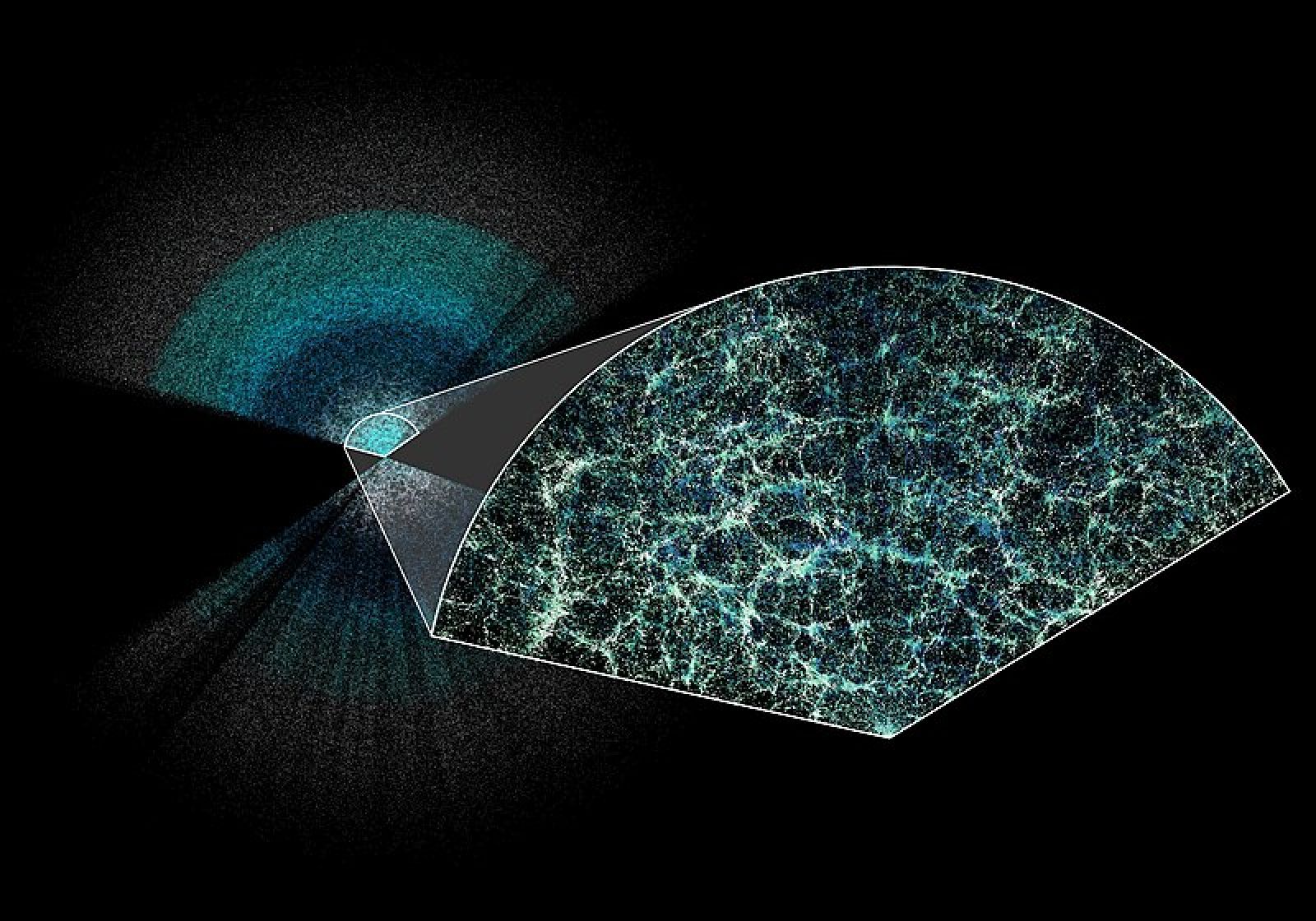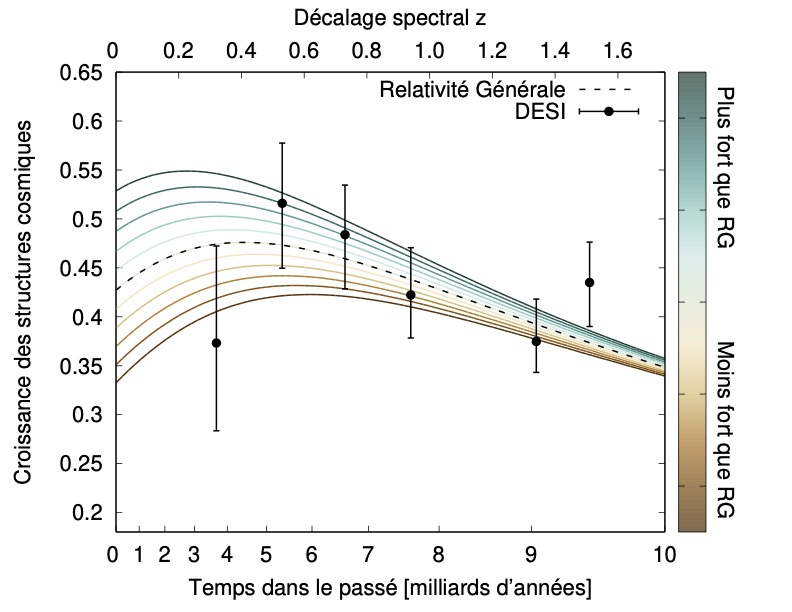Follow us on Google News (click on ☆)

The DESI instrument has created the largest 3D map of our Universe to date. This slice shows galaxies mapped during the first year of DESI's five-year survey. Earth is at the center of this thin slice of the full map. In the zoom-in section, the underlying structure of matter in our Universe is easy to see.
Their results confirm the validity of Einstein's theory of gravity, general relativity, on cosmological scales.
Gravity has shaped our cosmos, and under its attractive force, tiny density differences in the distribution of matter in the early Universe have evolved to form the galaxies and large cosmic structures we observe today.
A new study using data from the Dark Energy Spectroscopic Instrument (DESI) has traced the way these structures developed over the last 11 billion years, providing the most precise test yet of gravity on very large scales.
This new collaborative study is presented in several papers published on the online archive arXiv and available here. Its goal is to test the validity of Einstein's theory of gravity, general relativity, on cosmological scales. Some proposed modifications to this theory present alternatives to dark energy as explanations for the accelerating expansion of the Universe.
The international DESI collaboration, which includes over 900 researchers from more than 70 institutions worldwide, is led by Lawrence Berkeley National Laboratory (Berkeley Lab).
In this 360-degree video, take an interactive flight through millions of galaxies, mapped using DESI's observations.
Credit: Fiske Planetarium, CU Boulder and DESI collaboration.
Credit: Fiske Planetarium, CU Boulder and DESI collaboration.
Thus, the mechanism behind this accelerated expansion is being studied with two approaches. The first assumes the existence of a new component of the Universe, dark energy, whose properties are being investigated—particularly whether they evolve over time or remain constant. The second approach proposes modified gravity models compared to general relativity to explain the acceleration of the Universe's expansion without invoking dark energy.
In this new study co-led by Pauline Zarrouk, a CNRS cosmologist at the Laboratory of Nuclear and High-Energy Physics (LPNHE), the DESI collaboration researchers found that gravity behaves consistently with Einstein's theory of general relativity.
This result therefore validates the standard model of the Universe and limits possible extensions to general relativity. "General relativity has been extensively and precisely tested on the scale of stellar systems, but it was also necessary to verify that our assumption works on much larger scales," explains Pauline Zarrouk. "The statistical measurement of galaxy velocities over the history of the Universe allows us to directly test the theory of gravity."
"This is the first time we've performed this new complex analysis with DESI to trace the history of cosmic structure growth. Our results show that, so far, we align with what general relativity predicts on cosmological scales."
This simulation shows how gravity influences the position of observed galaxies, thereby altering how matter clumps together to form cosmic structures. As different gravity models predict differing formations, DESI scientists can compare observations with predictions to test gravity on cosmic scales.
Credit: Claire Lamman and Michael Rashkovetskyi / DESI collaboration.
Credit: Claire Lamman and Michael Rashkovetskyi / DESI collaboration.
The published results provide an in-depth analysis of data from DESI's first year, which, as of April, established the largest 3D map of the Universe to date and revealed hints of a potential evolution of dark energy over time. The April results focused on a specific feature in the spatial distribution of galaxies known as baryon acoustic oscillations (BAO).
The new analysis broadens the scope to extract more information, measuring how galaxies and matter are distributed across various scales of space. The study required months of additional work and cross-checks. As with the prior study, a technique was used to conceal the results from scientists until completion to avoid unconscious bias in analyses.
The complex analysis encompassed nearly 6 million galaxies and quasars located between 1 and 11 billion light-years from Earth. With just one year of data, DESI achieved the most precise global measurement of cosmic structure growth, surpassing previous efforts that took decades.
"Thanks to this wealth of data and the improvement in our analyses, the results obtained from this first year of data are spectacular," stated Arnaud de Mattia, a cosmologist at CEA Paris-Saclay and co-leader of the DESI group responsible for interpreting cosmological data. "We are testing the effect of dark energy and general relativity on cosmic scales with unprecedented precision."

This figure shows the measurements of cosmic structure growth as a function of spectral redshift, obtained from DESI data collected during its first year. The dashed black curve represents the prediction of general relativity, while the other colored curves show modifications to general relativity with stronger or weaker gravity than general relativity.
Credit: Héctor Gil-Marin and Pauline Zarrouk / DESI collaboration
The study also provided new upper limits on the masses of neutrinos, the only fundamental particles whose masses have not been precisely measured. Particle physics experiments indicate that the sum of the three types of neutrino masses must range between 0.06 eV/c2 and 1.35 eV/c2 (approximately one million times lighter than an electron). Under the standard cosmological model where dark energy is described by a cosmological constant, DESI's results suggest that the sum should be below 0.07 eV/c2 (at 95% probability), leaving a narrow window for neutrino masses.
"However, DESI's results can also be interpreted within a cosmological model where dark energy may vary over time, as recent observations suggest," notes Etienne Burtin, a physicist at CEA Paris-Saclay who co-led the DESI data analysis group. "In this framework, the upper limit of 0.19 eV/c2 is indeed higher, but it is far less dependent on the cosmological model used and remains more constraining than particle physics experiments."
DESI is a cutting-edge instrument capable of capturing light from 5,000 galaxies simultaneously. It was built and is operated with funding from the U.S. Department of Energy's Office of Science (DOE). DESI is mounted atop the 4-meter Nicholas U. Mayall Telescope of the National Science Foundation (NSF) at the Kitt Peak National Observatory. The experiment is now in its fourth year of a five-year sky survey and plans to collect data from approximately 40 million galaxies and quasars by the end of the project.
The DESI collaboration is continuing its observations and is currently analyzing data from the first three years of operations. It plans to present even more precise measurements of the Universe's expansion history and their implications for the nature of dark energy in spring 2025.
The French institutes contributing to the DESI program are the Institute for Research on the Fundamental Laws of the Universe (Irfu, CEA-Paris Saclay), the Laboratory of Nuclear and High-Energy Physics (LPNHE, CNRS / Sorbonne University / Paris Cité University), the Marseille Particle Physics Center (CPPM, CNRS / Aix-Marseille University), and the Astrophysics Laboratory of Marseille (LAM, CNRS / Aix-Marseille University / CNES).
DESI is supported by the U.S. Department of Energy's Office of Science and the National Energy Research Scientific Computing Center (NERSC), a computing center under the DOE Office of Science. DESI also benefits from support from the U.S. National Science Foundation, the UK's Science and Technology Facilities Council, the Gordon and Betty Moore Foundation, the Heising-Simons Foundation, the French Alternative Energies and Atomic Energy Commission (CEA), the National Council of Science and Technology in Mexico, Spain's Ministry of Economy, and DESI's member institutions.
The DESI collaboration is honored to have permission to conduct scientific research on the sacred Oligam Du'ag (Kitt Peak), a mountain of great significance to the Tohono O'odham Nation.